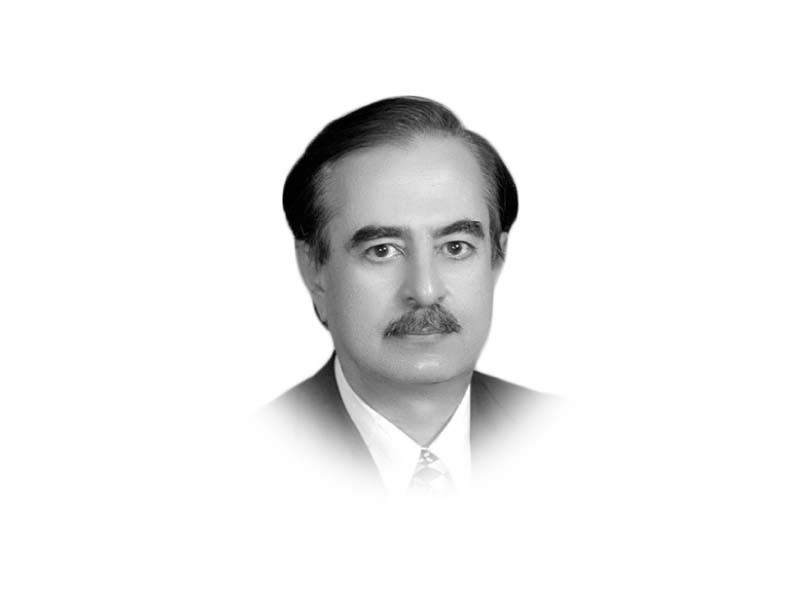
That one act of alleged hijacking, termed as the ‘Hijacking from the Ground’ in his book by the then DG CAA Aminullah Chaudhry, unfolding in the bracing evening skies of Karachi on 12 October 1999, unalterably changed the future of Pakistan in so many ways, economic, social, diplomatic and political.
The widely spread official and commonly accepted version of the supposed hijacking of Musharraf’s airplane on 12 October 1999 is explained as a justification for declaration of the last martial law, if ever, except under the Munirian doctrine, such meta-legal interventions can wear the garb of legality. The story goes that the then Prime Minister hijacked the plane or was the prime mover and planner behind it since he wanted to replace Musharraf.
The moot question however some ask is: even if the alleged attempted hijacking had not taken place and in the ordinary exercise of his legal prerogative the PM had attempted, metaphorically, to change hats in ‘Pindi, is it certain that it would not have led to the same results.
The PM was tried for the offence and convicted to life imprisonment after, anecdotally, the then army chief had desired imposition of a death sentence. The later penalty allegedly was held back on the intercession of heads of state of certain foreign countries. Later he had to undergo a life of exile for ten years, reduced later to about six. Originally hijacking as an offence was not part of the Anti-Terrorism Act and was subsequently added for the purpose of this specific case, applied retroactively.
During the next decade or so the country joined the US war on terror and faced the cataclysmic violent blowback that spread terror, death and destruction over the length and breadth of Pakistan.
The issue of who hijacked the plane, however, becomes slightly convoluted and murkier when one considers the evidence given by late Gen Shahid Aziz, the DG MO in 1999, in his 2013 autobiography, Aur Khamoshi Kahan Tuk, that sometime in September prior to leaving on an official tour of Sri Lanka, in a meeting held in the Army House attended by four others besides himself, viz the COAS, Cmdr X Corps, CGS and DG MI, it was decided that, as was imminently expected after spat over the Kargil adventure, that in case Musharraf was removed and replaced by another general, then anyone of them will activate implementation of the plan already devised to enforce reversal thereof or other actions warranted.
Ever since Gen Karamat had been politely shown the door by the then PM prior to his completion of his tenure on dilating upon how civilian supremacy should be moderated with a role for the military, the establishment high command had virtually sworn upon the honour of their institution that it would not, in future, take any such, so called, humiliating civilian interventions in their perceived organisational matters without demur. The Supreme Court in 2010 acquitted those penalised for lack of any substantive evidence.
The question that Aminullah raises is if legally a hijacking can take place if the person accused of the act is actually not on board nor is there any evidence that he or she forced the pilot directly and overtly to perform acts that he was not supposed to carry out in the routine performance of his duties on a certain flight.
Hijacking of a plane is an overt act whereby someone on board the aircraft, by threatening to use force or actual use of force or violence, forces the pilot or co-pilot to change the direction or course or to do any other act not provided in the ordinary course of prescribed functions or duty of the craft with a view to achieving a specific purpose or goal that is normally illegal.
According to Owen Bennett Jones in his book, Pakistan: The Eye of the Storm, on the basis of interviews he held with the pilot, co-pilot, passengers, the higher-ups and ground staff of CAA and PIA, the airplane ostensibly had enough fuel for Musharraf to allegedly force the pilot not to land at Karachi airport until he had reasonable confirmation that Corps Commander Karachi had taken control of the airport to ensure that men of Gen Ziauddin, the newly appointed COAS, did not arrest him on landing. Further, that the planned coup was well on its way to success with all bases covered.
Musharraf ostensibly ordered or forced the pilot to keep circling over Karachi airport until he had clearance from the ground that everything was under control of his own people as planned.
The first conversation Musharraf had with the Traffic Control was with Maj Gen Iftikhar when Gen Usmani, Corps Cmdr, Karachi reached ATC and told Musharraf: “Sir, This is Usmani.” Musharaf allegedly, to double-check that he was not being trapped, asked Usmani: “What is the name of my dog?” After Usmani gave the correct answer Musharaf told the pilot to land.
Owen Bennet Jones reaches the conclusion, based upon evidence and actual eye account, therefore that if anyone allegedly hijacked the plane it was probably the army boss himself, not allowing the plane to land and forcing it to hover over the airport until he had confirmation that Gen Usmani had taken over control of Karachi airport.
Considerable demands have to be placed upon reason and rationalisations made to logic and legal proof, to be able to accept that a person sitting in Islamabad was actually involved in hijacking a plane flying over Karachi. Even if complicity is to be proved, actual evidence and facts of conspiracy were never adduced and conviction was arrived at based upon mere surmises. That is why ultimately in 2010 the Supreme Court acquitted the then PM from the offence of hijacking, as no evidence to that effect was forthcoming.
Apparently, actually someone else was enforcing his will upon the pilot inside the cockpit and making him to obey his orders rather than the one who was eventually convicted. In some far stretched sense, upon this theory, therefore the prosecutor himself happened to be the accused.
Published in The Express Tribune, October 24th, 2022.
Like Opinion & Editorial on Facebook, follow @ETOpEd on Twitter to receive all updates on all our daily pieces.


1732243059-0/mac-miller-(2)1732243059-0-165x106.webp)

1672385156-0/Andrew-Tate-(1)1672385156-0-165x106.webp)
1732240377-0/mac-miller-(1)1732240377-0-165x106.webp)







COMMENTS
Comments are moderated and generally will be posted if they are on-topic and not abusive.
For more information, please see our Comments FAQ